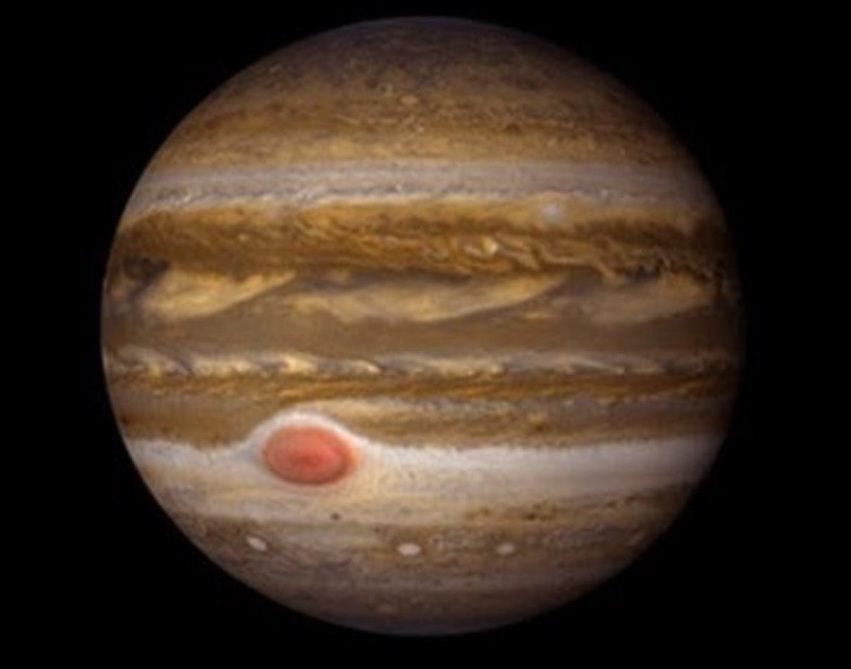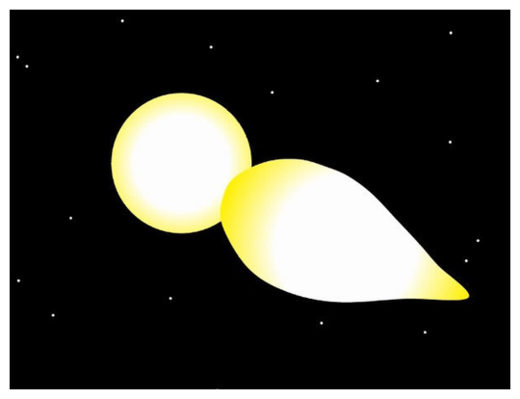
© AcksblogFig. 1. Jupiter clouds which remain unidentified
Most people do not realize that the various colored
clouds which cover the entire giant planet Jupiter are still a mystery. The first probe that reached the vicinity of Jupiter was Pioneer 10 in 3 Dec. 1973, roughly 34 years ago. Since that mission another 12 missions have visited the giant, each carrying a different complement of instruments. Juno, currently orbiting Jupiter, has made eight close passes to refine the data of earlier missions without explaining the makeup of the clouds.
Planetary scientists still believe that the giant planets comprise 90% hydrogen and 10% helium, however, this assumption is being seriously challenged by the Juno gravitational, magnetic field and energetic particle data.
Admittedly, nothing about the planet is turning out to be what they expected. This science has been plagued by the 'gas giant' assumption, with monumental steps being taken to make the data fit the the hypothetical model, rather than trying to understand their implications. The uniformitarion paradigm is the only one used to interpret data from every planet in the solar system.
Spectrometers can determine gaseous molecules by studying the spectral lines due to their chemical reactions or radiation emitted when high energy particles impact them. Molecules radiate more spectral lines in infrared spectrum when the air molecules impact one another due to collisions with other atoms. However, particulate aerosols suspended in an atmosphere, like volcanic clouds and smoke, usually <1 μm (micron), only radiate in broad spectral regions, seen as different colors, which do not enable the determination of their elemental composition.
Based on the 'gas giant' hypothesis, scientists predicted three distinct layers: ammonia, ammonium sulfide and water molecules. Since ammonia has not been identified, the hypothesis has been changed to ammonia ice, i.e. particles, suspended in the upper atmosphere. The colors of the clouds are now thought to be caused by aerosols "probably the result of subtle chemical reactions of the trace elements in Jupiter's atmosphere". The gases that have been definitely identified are water and methane, but the amount of water is less than expected, leading to an estimated low amount of oxygen.

© AcksblogFig. 2 The expanded incandescent Jupiter and the plume, known as Juno.
The Cyclic Catastrophism paradigm posits that Jupiter is a highly deuteraed, solid, low density Methane Gas Hydrate (MGH) body which formed cold in a Large Dark Nebula (LDN) where it incorporated the abundances of all the known elements in the solar system. MGH is a known clathrate, in which twelve or more water molecules form cages which physically encapsulate foreign atoms and molecules. Ancient texts of numerous cultures describe the birth of Venus out of the head of Jupiter, roughly 6,000-years BP (Before the Present). These 'myths' are telling the modern era, via cyclic catastrophism, what actually took place recently before their eyes in the heavens, much of it close above the Earth. The conclusions drawn from these seemingly simple myths reveal the true nature of every planet in the solar system.
The impact explosion from which Venus was born, triggered a fusion reaction on Jupiter, called Juno, which has diminished for 6,000 years, but still drives all the features we observe on Jupiter. As it burns, the heat releases the entire range of elements trapped in the local area. The elements react to form unique compounds in the high temperature around the fusion reaction, producing particulate aerosols as the hot vortex rises to the surface and cools, appearing as the Great Red Spot. These particulate clouds being continuously formed from the entire range of known elements, form the clouds of Jupiter. One good example is CS, carbon sulfide, which forms tiny red crystals as it cools. These crystals are what makes the GRS red. CS is also present in the high temperature lower atmosphere of Venus, still unrecognized by planetary scientists.
Amazingly, planetary scientists do not know that all the known elements are present in enormous numbers in and on Jupiter, most distributed throughout the entire planet, but over the last 6,000-years vast numbers have been cast into the atmosphere and have settled to the surface. Many heavy elements were revealed by the impacts of the larger Shoemaker-Levy 9 fragments on the solid surface of Jupiter, which caused fusion explosions, the rising mushroom clouds from which produced the 'main events' more than six minutes after they entered the atmosphere.
All of the giant planets are known to have methane in their atmospheres. This has never been satisfactorily explained. Its presence becomes obvious when we note their nominal composition, Methane Gas Hydrate, is (CH4)4(H2O)23 . Therefore methane, which does not condense, is continuously being released by the fusion burning on Jupiter and by any comets that impact on the surfaces of the other giants.. Water is also released but as it rises in the hot vortex it combines with many of the heavy elements producing compounds that become unrecognizable aerosols and that which does not condense falls as rain to the surface of Jupiter forming an ice mountain range which I have predicted lies to the east of the GRS at 22 deg. S. Latitude. The Juno gravity instrument should detect this feature.
Reader Comments
to our Newsletter